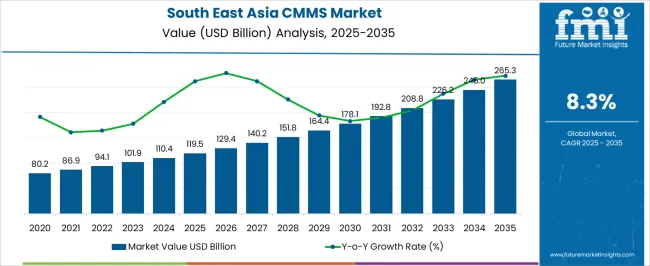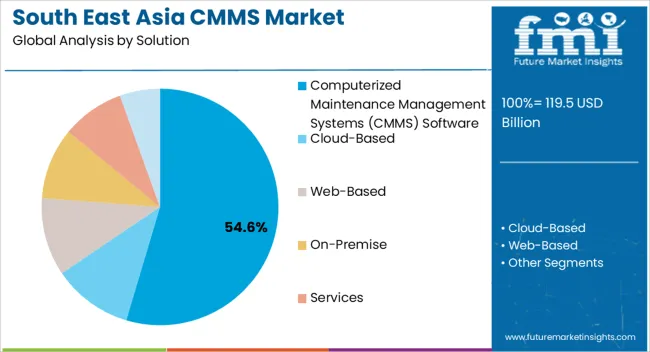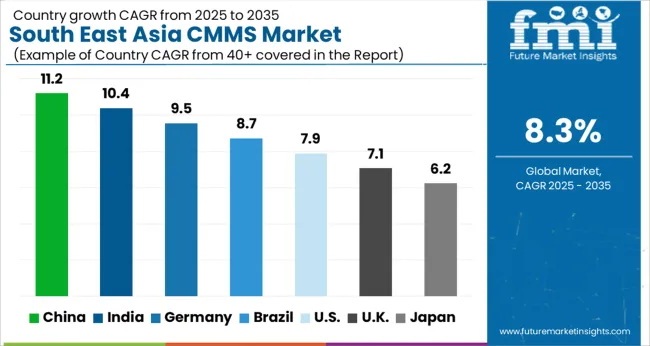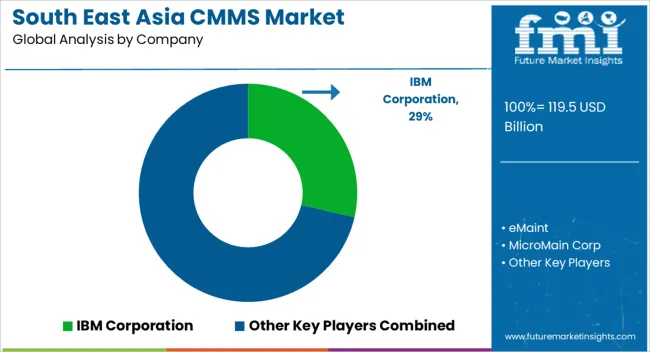The South East Asia CMMS Market is estimated to be valued at USD 119.5 billion in 2025 and is projected to reach USD 265.3 billion by 2035, registering a compound annual growth rate (CAGR) of 8.3% over the forecast period.

| Metric | Value |
|---|---|
| South East Asia CMMS Market Estimated Value in (2025 E) | USD 119.5 billion |
| South East Asia CMMS Market Forecast Value in (2035 F) | USD 265.3 billion |
| Forecast CAGR (2025 to 2035) | 8.3% |
The South East Asia CMMS market is expanding rapidly due to rising demand for digital maintenance solutions, asset management efficiency, and regulatory compliance across industries. Increasing adoption of cloud based platforms and mobile integration has enabled businesses to improve equipment uptime, reduce operational costs, and enhance predictive maintenance strategies.
The shift from reactive to proactive maintenance practices is driving investments in CMMS solutions, particularly as industries aim to minimize downtime and improve productivity. Growing emphasis on workplace safety, audit readiness, and sustainability targets is also contributing to market momentum.
With governments and enterprises in the region pushing digital transformation initiatives, the CMMS market outlook remains positive as organizations continue to seek scalable, data driven, and user friendly platforms to streamline maintenance management.

The CMMS software solution segment is expected to hold 54.60% of the total market revenue by 2025, making it the dominant solution type. Growth in this segment is driven by its ability to centralize maintenance operations, automate scheduling, and optimize asset lifecycle management.
CMMS software enables organizations to track work orders, monitor inventory, and reduce downtime while ensuring compliance with safety and operational standards. Enhanced cloud deployment models and mobile accessibility are also improving user adoption across businesses of all sizes.
The demand for actionable insights through data analytics and performance reporting has further strengthened the position of CMMS software as the preferred solution within the market.
South East Asia computerized maintenance management systems (CMMS) market witnessed a CAGR of 5.5% from 2020 to 2025. It is likely to exhibit a CAGR of 8.3% in the assessment period from 2025 to 2035.
A CMMS can aid in compliance with safety and regulatory standards. It can also support data-driven decision-making for maintenance and capital planning.
A CMMS is an essential tool for any organization looking to improve maintenance efficiency and maximize asset value. By automating maintenance tasks, a CMMS can also reduce the risk of human error and improve the accuracy of maintenance records. It can lead to better asset management and increased productivity in the end.
Top South East Asia CMMS Market Trends Listed by Future Market Insights (FMI):

Industries in Singapore to Adopt Asset and Maintenance Management Software to Reduce Downtime
Several industries in Singapore rely on complex equipment such as manufacturing machinery, shipping vessels, and aviation equipment to operate. A CMMS helps organizations to manage the maintenance and repair of their equipment. It further ensures that it operates at peak efficiency and minimizes downtime.
By using a CMMS, organizations can also track the performance of their equipment over time. It allows them to make data-driven decisions about when to replace or upgrade their assets. It can help a company’s unnecessary expenditure by avoiding costly breakdowns and extending the lifespan of their equipment.
Industries in Singapore are expanding their reach by using CMMS. It makes it easier for them to persevere in ongoing operations in an efficient manner. It would help Singapore to exhibit around 10.4% CAGR from 2025 to 2035.
Malaysia-based Firms to Demand Computerized Maintenance Software to Improve Productivity
CMMS can help organizations in Malaysia better manage their assets. It provides them with detailed information about their maintenance history, conditions, and lifecycle. By using this information, organizations can make data-driven decisions about when to repair or replace assets, which can help them maximize their return on investment.
CMMS can also help organizations track inventory and supplies, ensuring that they have the necessary parts and materials on hand to complete maintenance tasks. It can help reduce downtime and improve productivity. Maintenance teams are able to quickly access the parts they need without having to wait for orders to be fulfilled.
CMMS is a powerful tool that can help organizations in Malaysia streamline their maintenance operations, improve asset management, and ensure compliance with regulatory requirements.
As more organizations recognize the benefits of adopting CMMS, it is becoming an increasingly popular solution in Malaysia's industrial landscape. Malaysia is projected to expand at a CAGR of 10.3% in the South East Asia computerized maintenance management system market through 2035.
Companies in Vietnam to Adopt CMMS for Manufacturing to Increase Asset Lifespan
Vietnam has been undergoing rapid industrialization over the past decade, which has resulted in growth of various manufacturing industries. There is hence a growing need for maintenance management solutions to keep up with maintenance needs of these industries.
There is now a greater awareness of the benefits of regular maintenance, which has led to increasing CMMS demand. Companies are realizing that implementing a CMMS can help reduce downtime, increase asset lifespan, and improve their productivity.
Adoption of technology in Vietnam is on the rise, and businesses are increasingly turning to software solutions to help manage their operations. There is a growing demand for CMMS solutions as businesses look to streamline their maintenance processes. The country is estimated to showcase a CAGR of 6.3% in the next ten years.
Energy & Utility Companies to Use Maintenance Management System Software to Prevent Equipment Failure
Based on industry, the energy & utilities sub-segment under infrastructure segment is estimated to remain at the forefront by 2035. Computerized maintenance management systems (CMMS) are widely used in South East Asia energy and utilities sector.
These are required to manage the maintenance of critical infrastructure such as power plants, transmission lines, and distribution networks. CMMS helps energy & utilities companies to optimize maintenance activities, reduce downtime, and improve equipment reliability.
One of the key benefits of using CMMS in this sector is that it enables companies to schedule preventive maintenance tasks based on criticality of the equipment. It further helps to reduce the risk of equipment failure and unplanned downtime.
CMMS also allows energy & utilities companies to track the performance of their equipment, identify potential problems, and schedule maintenance activities accordingly. It helps to minimize the total cost of ownership of equipment.
It identifies equipment that needs to be replaced or upgraded before it fails. The sub-segment had generated a market share of 41.2% in 2025.
Computerized Maintenance Software to Help Telecommunication Companies Support Service Delivery
Use of computerized maintenance management systems (CMMS) in the telecommunications industry is expected to drive growth in the market. The telecommunication industry relies heavily on a vast network of equipment and infrastructure to support the delivery of services such as voice, data, and video transmission. Efficient management of maintenance operations is hence critical to ensuring optimal network performance and reducing downtime.
CMMS software can help telecommunications companies in South East Asia manage their maintenance operations more effectively. It provides real-time insights into equipment performance.
It further helps in automating work order scheduling & tracking and enabling preventive maintenance. It can help to reduce downtime, improve equipment reliability, and extend the lifespan of assets, which can result in significant cost savings. The telecommunication industry sub-segment is projected to showcase a CAGR of 7.8% in the next ten years.
On-premise CMMS for Maintenance to Witness High Demand as Need for Customization Rises
On-premise CMMS software refers to software that is installed and runs on an organization's own servers or computers. It is in contrast to cloud-based CMMS software, which is hosted on remote servers and accessed via the internet. A few organizations might have security concerns about storing their maintenance data in the cloud.
On-premises CMMS software allows organizations to keep their data on their own servers, where they have complete control over its security. It also gives organizations more control over their maintenance data. They can choose when and how to back up the data and do not have to put about internet connectivity or cloud service disruptions.
On-premises CMMS software can further offer more control, customization, and security over their maintenance data. The service requires more upfront costs and ongoing maintenance compared to cloud-based solutions. On-premises services provide security and control over the maintenance management systems.
Such a software solution can often be customized to fit the specific needs of an individual company, providing a more tailored experience for users. The segment accounted for a considerable market share of 44.9% in 2025.
Medium-sized Enterprises to Use Low-cost CMMS Software to Track Work Orders
Medium-sized enterprises use CMMS to schedule preventive maintenance tasks such as inspections, lubrication, and cleaning. By scheduling maintenance tasks in advance, they can ensure that equipment is well maintained. It can further help to reduce downtime and extend the life of assets.
CMMS allows medium-sized enterprises to create, manage, and track work orders. It includes assigning tasks to specific maintenance staff, tracking the progress of work orders, and closing out completed work orders.
It further helps to ensure that maintenance activities are organized and completed on time. The segment is projected to generate a market share of 28.1% in 2025.

South East Asia CMMS market is getting highly competitive with a number of established players. These players offer a wide range of maintenance solutions such as preventive maintenance scheduling, work order management, and asset management.
Recent developments:
| Attribute | Details |
|---|---|
| Estimated Market Size (2025) | USD 119.5 billion |
| Projected Market Valuation (2035) | USD 265.3 billion |
| Value-based CAGR (2025 to 2035) | 8.3% |
| Forecast Period | 2025 to 2035 |
| Historical Data Available for | 2020 to 2025 |
| Market Analysis | Value (USD million) |
| Key Countries Covered | Singapore, Malaysia, Thailand, Philippines, Vietnam, Indonesia, Rest of South East Asia |
| Key Segments Covered | The solution, Enterprise Size, Industry, and Country |
| Key Companies Profiled | IBM Corporation; eMaint; MicroMain Corp; Infor; Maintenance Connection (Accruent); Hippo CMMS; Limble CMMS; Rockwell Automation (Fiix Inc.); UpKeep; Dude Solutions; Connecteam; Maintain X |
| Report Coverage | Market Forecast, Company Share Analysis, Competition Intelligence, Market Dynamics and Challenges, and Strategic Growth Initiatives |
The global south east asia CMMS market is estimated to be valued at USD 119.5 billion in 2025.
The market size for the south east asia CMMS market is projected to reach USD 265.3 billion by 2035.
The south east asia CMMS market is expected to grow at a 8.3% CAGR between 2025 and 2035.
The key product types in south east asia CMMS market are computerized maintenance management systems (cmms) software, cloud-based, web-based, on-premise, services, consulting services, _integration & implementation services and _support & maintenance.
In terms of enterprise size, small offices (1 to 9 employees) segment to command 42.5% share in the south east asia CMMS market in 2025.






Full Research Suite comprises of:
Market outlook & trends analysis
Interviews & case studies
Strategic recommendations
Vendor profiles & capabilities analysis
5-year forecasts
8 regions and 60+ country-level data splits
Market segment data splits
12 months of continuous data updates
DELIVERED AS:
PDF EXCEL ONLINE
South Korea Intellectual Property Market Size and Share Forecast Outlook 2025 to 2035
Southern Blotting Market Size and Share Forecast Outlook 2025 to 2035
South Africa Casino Tourism Market Size and Share Forecast Outlook 2025 to 2035
South Korea Sports Tourism Market Size and Share Forecast Outlook 2025 to 2035
South Korea Tourism Market Trends - Growth, Demand & Analysis 2025 to 2035
South Korea Power Tools Market Report – Trends, Demand & Growth 2025-2035
South Africa Safari Tourism Market Analysis – Growth, Trends & Forecast 2025-2035
South Korea Respiratory Inhaler Devices Market Insights – Trends, Demand & Growth 2025 to 2035
South Korea Mobile Sterile Units Market Report – Growth, Demand & Forecast 2025-2035
South Korea Hyaluronic Acid Products Market Growth – Trends, Demand & Innovations 2025-2035
South Korea DNA Polymerase Market Growth – Innovations, Trends & Forecast 2025-2035
South Korea 3D Bioprinted Human Tissue Market Trends – Demand & Forecast 2025-2035
South America Tourism Market Growth – Trends & Forecast 2024-2034
South Africa Faith-Based Tourism Market Growth – Forecast 2024 to 2034
South America Residential Water Treatment Equipment Market Trends – Growth & Forecast 2022 to 2032
Southeast Asia Submersible Pumps Market Growth – Trends & Forecast 2025 to 2035
Southeast Asia Pet Care Market Trends – Demand, Growth & Forecast 2022-2032
Australia and South Pacific islands Tourism Market Size and Share Forecast Outlook 2025 to 2035
Demand for Geosynthetics in South Asia Size and Share Forecast Outlook 2025 to 2035
Taurine Industry Analysis in South Korea - Trends, Market Insights & Applications 2025 to 2035

Thank you!
You will receive an email from our Business Development Manager. Please be sure to check your SPAM/JUNK folder too.
Chat With
MaRIA